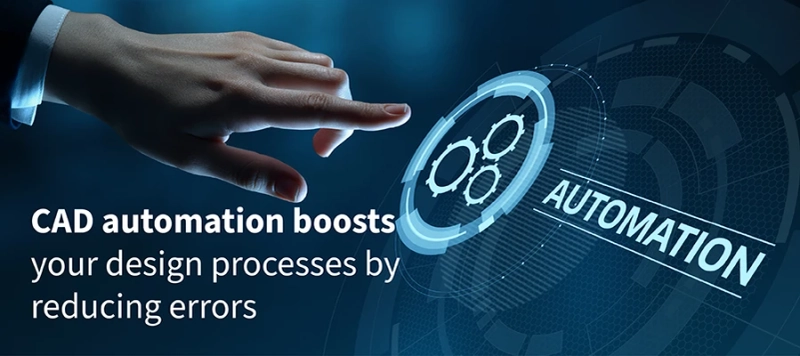The pressures of increasing complexity in designs and shorter deadlines are things engineers struggle with in their daily work. Manual CAD processes compound the pressures as huge time has to be spent on repetitive tasks or designs remain vulnerable to human errors.
CAD automation takes these pressures off by streamlining design workflows and reducing errors systematically. Teams can standardize their design practices through automated design tools and enjoy both productivity gains and more reliable outputs. This helps design engineers focus on creative design work rather than on repetitive tasks.
In this article, we explore practical design automation techniques that dramatically improve design efficiency and impact project timelines. An examination of the available tools and implementation strategies provides a roadmap for engineering teams looking to modernize their CAD workflows.
Error reduction through automated validation
Design automation implements systematic error prevention through automated validation protocols. CAD software automation conducts real-time checks against predefined engineering rules and standards. When you create features or modify designs, the system automatically validates wall thicknesses, clearances and manufacturing constraints.
Standardization enforcement
Design process optimization through automation enforces standardization across your CAD database. The system maintains consistent naming conventions, file structures, and design practices. This design standardization eliminates errors from inconsistent modeling approaches or non-compliant design practices.
Geometric validation
Advanced CAD automation systems incorporate geometric validation algorithms that verify the preservation of design intent. The software analyzes geometric relationships, dimensional constraints, and feature dependencies to ensure design modifications maintain critical parameters. CAD error reduction through this validation prevents unintended changes that could compromise product functionality.
Productivity enhancement through automated workflows

CAD productivity increases significantly through automated feature generation and design replication. Parametric design capabilities allow you to create intelligent models that automatically update when key parameters change. This automation eliminates manual updates and ensures design intent preservation throughout iterations.
Time savings in design generation
Design workflow improvement through automation reduces the time spent on repetitive modeling tasks. Engineers save a major part of design time through automated feature generation compared to manual modeling approaches.
Template-based design systems
The implementation of template-based design automation accelerates initial design creation. Engineering teams develop standardized templates that incorporate company best practices and design rules. These templates serve as foundations for new designs, ensuring consistency while reducing the three-fourths of the initial setup time.
Integration and data management
Modern CAD automation platforms offer comprehensive integration capabilities. CAD integration with PDM/PLM systems creates a seamless data flow between design and management tools. Popular automation platforms include:
- SOLIDWORKS Automation API
- Autodesk Inventor iLogic
- DriveWorks Pro
Customization capabilities
CAD customization through CAD scripting allows you to create specialized automation tools for your specific requirements. These custom solutions automate company-specific design rules and workflows, further enhancing productivity.
Enterprise system integration
Advanced design automation systems integrate with enterprise resource planning (ERP) and manufacturing execution systems (MES). This integration enables automated bill of materials generation, cost estimation, and manufacturing planning, creating a unified digital thread throughout the product lifecycle.
Impact on development timeline
Design automation significantly compresses product development cycles. Automated systems reduce design iteration time by:
- Eliminating manual updates to dependent features
- Automating drawing generation and documentation
- Reducing review cycles through automated validation
- Enabling rapid design modifications and variations
Concurrent engineering support
CAD automation enables effective concurrent engineering practices. Multiple engineers can work simultaneously on different aspects of a design, while automated systems maintain design intent and prevent conflicts. This parallel workflow capability reduces development time by up to 40% compared to sequential design approaches.
Change management automation
Automated change management processes in design automation systems streamline design iterations. The software tracks modifications, updates dependent features, and maintains documentation synchronization automatically. This automation reduces the change implementation time while ensuring complete change propagation throughout the design.
Case Study:
CAD automation reduces design cycle time by 70% for door manufacturing

A USA-based manufacturer of hollow metal doors and frames sought to streamline their design process. The client required automation of 3D CAD modeling and manufacturing drawings to reduce engineering lead times and improve response to customer inquiries.
Hitech CADD Services collaborated with the client's design engineers to implement a custom door configurator using DriveWorks Solo. This solution automated the generation of 3D models and manufacturing drawings, integrating a SQL database for efficient design data management and minimizing errors associated with manual customization.
The final deliverables led to:
- 70% reduction in design cycle time, accelerating product delivery
- Over 70,000 doors designed, enhancing production capacity
- 99% improvement in design quality, leading to increased customer satisfaction
Quantifiable benefits of CAD automation
CAD automation tasks translate to significant reductions in design errors stemming from manual data entry or repetitive operations. Model-based definition (MBD) eliminates ambiguity by using machine-readable 3D CAD and Product Manufacturing Information (PMI) for automation, minimizing errors from manual interpretation of 2D drawings. This streamlined design automation process improves design quality and consistency.
Automated verification tools integrated within the design process identify potential design flaws early, further reducing errors and rework. Engineering automation within CAD enables faster design revisions and explorations, leading to optimized designs and reduced time to market.
Quantifying these benefits of using automated design tools involves metrics such as error rate reduction, design cycle time improvement, and cost savings from reduced rework and faster project completion.
Wrapping up
CAD automation represents a fundamental shift in design methodology, delivering substantial error reduction and productivity gains. By implementing automated validation, standardized workflows, and intelligent design systems, you eliminate manual errors while accelerating design processes. The integration of automated design tools with enterprise systems creates a robust framework for consistent, efficient design operations.
When you adopt design automation, you position your engineering operations for increased throughput, improved quality, and faster time-to-market. The quantifiable benefits of error reduction and productivity enhancement make automation an essential strategy for modern CAD operations.



